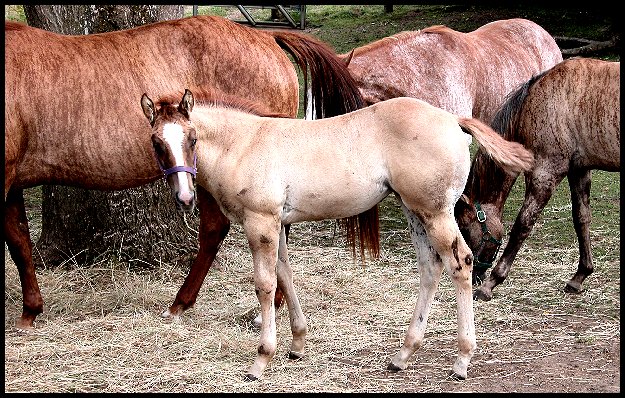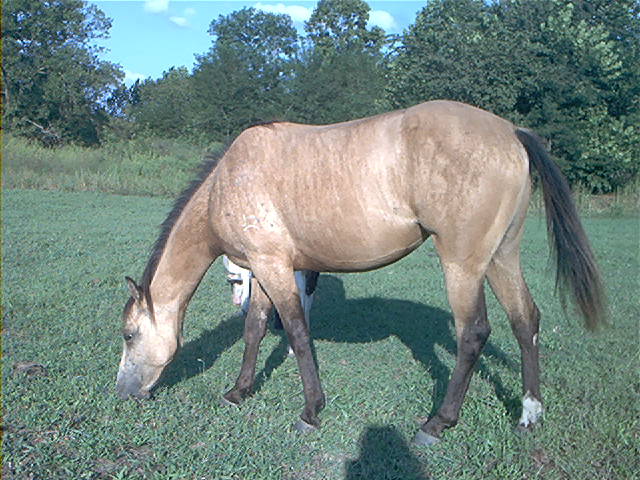 Brindle Horses
Brindle Horses
(Donkeys and Mules too!)
Click type to jump to that section!
 Bits N Pieces / Registries
Bits N Pieces / Registries
 Brindle Horses Slideshow
Brindle Horses Slideshow
 History of Brindles
History of Brindles
 Archive of Previous Articles
Archive of Previous Articles
 General Information
General Information
 Brindle Characteristics
Brindle Characteristics
 You Can Help!
You Can Help!
 Update & Contact Information
Update & Contact Information
 Breeders & Stallion Listings
Breeders & Stallion Listings
 Yipes! Stripes! - Color in Horses website
Yipes! Stripes! - Color in Horses website
Bits N Pieces
I have heard that on October 31 AOL is shutting down the AOL Hometown webpages. I don't know if it will affect my Brindle Horse webpages on members.aol.com. However, to be on the safe side I have set up a mirror site at:
http://www.geocities.com/sbatteate
We now have a logo at the top of the page that characterizes the brindle pattern. Notice the striping is drippy looking and not regularly spaced. There is often a swirl over the hip, and vertical striping in the flank, which is not usually seen with other dilutions or sooty striping.
The Slideshow has now also been updated. It is split into two portions: One for full patterned brindles, and the other for partial or indeterminate patterns.

Pictured are 3 very nicely marked brindles and a foal owned by Denise Charpilloz. She has leased my brindle producing stallion for this year to breed to her mares. We're keeping our fingers crossed for more of those brindle stripes.
Visit her website at www.sharppillows.com
Janelle Johnson just sent me a picture of her 2005 filly from the brindle mare Im A Star Moon Bar. Janelle says the filly is almost a carbon copy of her dam. Janelle had leased my brindle producing stallion in previous years, so she has a number of foals for sale. There is a link to her webpage in the breeders section and/or at Just A Splash of Paint.

Articles on Brindles
In relation to recent articles on the Brindle pattern, please keep in mind that Chimerism is NOT the only source of the Brindle pattern in all Brindle horses. I have had two lines in which the pattern has been inheritable. The mare Brenda Batty Atty, has had 3 brindled offspring (3 brindled of 5 total foals). Also, the mare Im A Star Moon Bar (3 brindled of 5 + 1 carrier), and her son Ima Star Brindle Bar (5 brindled from 7 breedings while I had him), have all had brindled foals. I have also had reports of Brindle offspring from others. Hopefully I will be able to get to an update of the table soon.
Articles written by Christine Hamilton on Chimerism as an origin of some brindle patterns have appeared in recent magazines. I understand the March issue of "America's Horse" has an article by Christine. There was also an article in the November 2006 issue of "Equus," and in the February 2006 issue of the Quarter Horse Journal, in an article called "One in a Million". The article detailed the work headed by Cecilia Penedo, PH.D., at UC Davis in the DNA testing of a foal by Dunbar's Gold out of Sharp One, both of which exhibited a phenotypical (outward appearing) brindle pattern.
Extremely rare, chimmerism has been documented in other species, and is now documented in Horses as a result of the work at UC Davis. Dr. Cecilia Penedo also presented her findings at The Horse Genome Mapping Workshop that was held on Aug. 22 in Port Seguro, Brazil.
Registries
There is a new registry for brindle horses only, started by Kay Isaac in 2008 called the American Brindle Equine Association. She is registering brindle horses, donkeys, mules, ponies, and miniature horses, but no zebra or zebra hybrids. She says her registry will have a searchable database, distance awards, medals, and prizes. Contact her for more detailed information at e-mail, or you can write the A.B.E.A. c/o Kay Isaac, 22871 North St. Hwy 21, Blackwell, MO 63626.
There is a registry for brindle horses started by Anita Garza in 1998 called the Brindle and Striped Equine International. She is registering brindle, heavy dun factor, "netting", horses, zebra hybrids, zebras, donkeys, mules, ponies, etc. She says her registry will have a Register of Merit awards program. Contact her for more detailed information at 409-793-4207, e-mail, Anita Garza, 11819 Puska, Needville, Texas, 77461.
Some brindle horses can be registered with the IBHA as "brindle dun". They have had the category "brindle dun" since approximately 1971. Unfortunately they aren't able to produce a list of horses registered as this color since most occurred prior to computer searches being generally available. Visit their website for more information, or contact: (219) 552-1013, International Buckskin Horse Association, PO Box 268, Shelby, IN 46377.
The International Striped Horse Association started by Mary Jagow in 1988 has been closed in March 1999 as per Mary Jagow.
Brindle Horses Slideshow
This slideshow was last updated November 5, 2008. To see if new pictures were added since the last time you were here, you may have to "refresh" or "reload" your screen. Remember, these photos in the slideshow are for informational purposes only, in order to educate people on how variations in the Brindle pattern can look. Most of these photos are copyrighted and cannot be reproduced without permission. There is a link at the bottom of the page to a photo that can be printed out and distributed to your friends if you wish. If you have trouble with the slideshow, the pictures can also be viewed through our Table of Brindles. The photos on the table, even though small, take a while to load because they are links to larger photos, and the larger photos are the ones that are being loaded. However, you can scroll down and read the table, and click on the unloaded photo box to jump to that larger picture if you wish. If it shows the photo as being not found, it is one of the photos I haven't completed yet.

Click picture to start slideshow ---->>
Some browers may not play the show automatically, so you may need to click each picture to proceed. Also, you may just click each picture if you want to scroll faster through pictures you have already seen.
We are looking for other Brindle Horses, or information on the Brindle pattern, for a study. Brindle in Horses is very rare. Most people are more familiar with the Brindle pattern in Dogs or Cattle. If you come across any Brindle Horses, or information on the pattern in reference to horses alive or deceased, please let us know.
General Information
The Brindle pattern consists of a watery or drippy looking striping (sometimes just partial striping) over the body of an animal. It is more commonly seen in dogs or cattle. In horses, the pattern is extremely rare. Brindle has occurred in such diverse breeds as Arabians, Thoroughbreds, Mustangs, Quarter Horses, Tennessee Walking Horses, German and Bavarian Warmbloods, Russian Horses, Spanish Horses, and also in Donkeys and Mules.
The first record of the Brindle Pattern in Horses seems to be by J.A. Lusis, in the publication Genetica vol.23, 1942. In the article on "Striping Patterns in Domestic Horses", he details a Russian cab horse from around the 1800's, that was preserved and put in a museum. Reports of Brindle or Brindle Dun patterns from the 1860's to 1870's in the Criollo horses of South America have been documented by writers such as Marrero, Pereyra, Solanet, and Odriozola.
Many people confuse the Brindle pattern with Dun Factor markings (stripe down the back, barring on the legs, and occasional regular-spaced striping down the ribs). At one time, it was thought Brindle was a just a variation of Dun Factor. Indeed, there have been many examples of horses that were probably carrying both Dun Factor and Brindle. However, as can be seen from pictures of numerous Brindles in our slideshow, many do not have any Dun Factor markings whatsoever, indicating the two patterns are probably distinct genetically. Click highlighted type to compare Dun Factor and Brindle.
Brindle horses also have texturing in their coat, similar to that seen in some Appaloosa horses. The pattern seems to be inheritable, especially in terms of coat texturing, but the expression of the darker or more intense pigment to make the pattern visible is highly variable, and even varies with individual horses seasonally / yearly. Sometimes the pattern seems to be composed of dark hair (black or brown), sometimes of white hair (roan or gray).
Information collected since 1990 on Brindle horses is now shedding some light on the Brindle pattern. It now appears there may be two ways in which a Brindle phenotype (outward appearance) can occur. In some horses, the pattern has not been inheritable, pointing to a possible mosaic or chimeric origin, such as seen in tortoiseshell cats. In other horses, the pattern has been shown to be inheritable. However, there could be several genes involved, producing similar patterns (much as pinto/paint spotting can result from several different genes).
The most recent book mentioning the Brindle Pattern is Jeanette Gower's book Horse Colour Explained, 1999, Kangaroo Press, available thru 20 Barcoo Street, East Roseville NSW 2069. Another book is Phil Sponenberg's book on Equine Color Genetics, 1996, Iowa State University Press, Ames, Iowa, 50014. Another good book on genetics, is Ann Bowling's new book Horse Genetics, 1996, CAB International, available thru Oxford University Press, 2001 Evans Rd, Cary, North Carolina, 27513.
Update & Contact Information
Written information was last updated © November 5, 2008. When returning to this site, remember to select the refresh or reload icon from your internet explorer tool bar at the top of the screen, so your screen will reload the latest information. The address of this web site is http://www.geocities.com/sbatteate
You may e-mail me at [email protected]
Click here to e-mail me!
You may also contact me: (209) 477-1536, J. Sharon Batteate, PO Box 8535, Stockton, CA 95208 USA
Click this type for a picture of a Brindle Horse with contact information you can print.
Unless otherwise noted, the articles on this site are by J. Sharon Batteate [email protected] The pictures and information on this site are for informational purposes, in order to educate people on the Brindle pattern. The pictures and information on this site are copyrighted. All rights reserved. No part may be reproduced, stored in a retrieval system, or transmitted in any form or by any means, electronic, mechanical, photocopying, recording, or otherwise, without the prior permission of the copyright holders.
Thanks For Coming!
 Bits N Pieces / Registries
Bits N Pieces / Registries Brindle Horses Slideshow
Brindle Horses Slideshow  History of Brindles
History of Brindles Archive of Previous Articles
Archive of Previous Articles General Information
General Information Brindle Characteristics
Brindle Characteristics You Can Help!
You Can Help!  Update & Contact Information
Update & Contact Information Breeders & Stallion Listings
Breeders & Stallion Listings Yipes! Stripes! - Color in Horses website
Yipes! Stripes! - Color in Horses website


